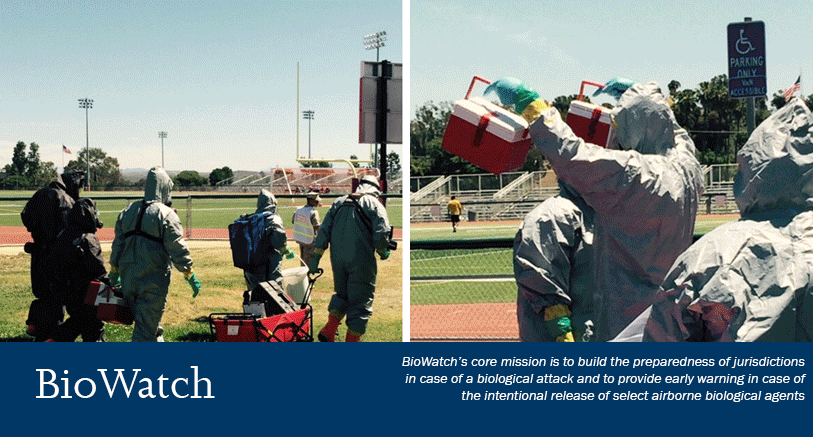The BioWatch Program

A bioterrorist attack against the United States is a continuing threat with potentially devastating consequences, including mass casualties, economic instability, and critical infrastructure disruption.
The Department of Homeland Security’s BioWatch Program provides early detection of a bioterrorism event and helps communities prepare a coordinated response. The combination of detection, rapid notification, and response planning helps federal, state, and local decision-makers take steps to save lives and mitigate damage.
BioWatch is managed by the Office of Health Affairs in the Department of Homeland Security, supported by other federal agencies, and operated by a network of scientists, laboratory technicians, emergency managers, and public health officials in each of the 30+ BioWatch jurisdictions.
BioWatch air monitoring and analysis, notification procedures, and risk assessment can eliminate or substantially minimize the catastrophic impact of a biological attack. BioWatch also gives public health, law enforcement, emergency management, and laboratory communities a forum to help develop a common understanding of a bioterrorism incident, focus resources, and determine the appropriate response.
BioWatch gives decision-makers the actionable information at the earliest possible time with the tools and training to help coordinate an effective response.
The BioWatch Program is a component of OHA's Health Threats Resilience Division.
Mission
To operate a nationwide, aerosol detection system providing early warning across all levels of government to support public health and emergency management communities to prepare for and respond to biological incidents.
Program Overview
BioWatch is the nation’s only system for early warning of an aerosolized biological attack and a cornerstone of the DHS comprehensive strategy for countering terrorism.
Bioterrorism Detection
BioWatch collectors are strategically positioned around the country to continuously monitor the air for biological threats. Every day in every jurisdiction, BioWatch collectors draw air into filters for analysis. BioWatch field technicians collect and transport the filters, and laboratory professional analyze them for evidence of biological threats in the surrounding air.
Public Health Preparedness
BioWatch also helps jurisdictions around the country develop response plans to prepare for worst-case scenarios. Local, state, and federal BioWatch stakeholders hold exercises to test, evaluate, and continually improve coordination, communication, and decision making in the event of a biological attack. BioWatch does this by:
- Coordinating exercises and drills
- Developing standardized methodologies for response
- Enabling a forum for all levels of government to share information
- Providing training, guidance and assessments
Stakeholder Involvement and Collaboration
BioWatch coordinates with state and local public health organizations, first responders, law enforcement personnel, and local federal officials. BioWatch coordination with stakeholders results in communities that are better prepared for a biological attack and an all-hazards response.
- Federal Partners: BioWatch federal partners include the Federal Bureau of Investigation, Centers for Disease Control and Prevention, Department of Health and Human Services, the Department of Defense, and the Environmental Protection Agency.
- State and Local Jurisdictions: BioWatch jurisdictions and federal agencies work together to ensure the overall resilience of the program’s operations and the coordinated response effort. Each BioWatch jurisdiction has established a BioWatch Advisory Committee--a group of its stakeholders and external partners, who meet regularly to discuss and review operations and response plans.
Key Program Activities
- Public Health and Preparedness: BioWatch exercises, drills, and other activities advance national preparedness. For example, in fiscal year 2015, 500 state and local partners from a range of disciplines and agencies participated in BioWatch preparedness activities.
- Environmental Assessment: The BioWatch Program coordinates and integrates environmental assessment activities across all BioWatch. BioWatch helps jurisdictions create and update environmental sampling plans for responding to a BioWatch detection.
- Special Events Monitoring: BioWatch monitors the air for biological agents at major national events and designated National Special Security Events. BioWatch has monitored the air for threats at Super Bowls major sporting events, national political conventions, and high profile visits and meetings, such as the 2015 Papal visit to three U.S. cities.
- Laboratory Operations: BioWatch analyzes more than 200,000 samples a year in more than 30 jurisdictions. BioWatch works closely with the Centers for Disease Control and Prevention’s Laboratory Response Network, an integrated system of laboratories that can respond to public health emergencies. Close collaboration helps ensure confidence in lab results and an efficient response across the government.
- Field Operations: BioWatch engages more than 200 local, state, and federal partners and stakeholders to manage daily filter collections, quality assurance testing, and staff training.
- Communication: BioWatch coordinates a monthly webinar series and organizes a semi-annual stakeholder workshop. Each event provide a forum for partners and stakeholders to exchange information to help strengthen preparedness for a bioterrorism detection.
- Quality Assurance: BioWatch works with federal partners and field and laboratory operations teams to ensure BioWatch quality standards are met and results are defendable.
Leadership
The BioWatch Program is led by Michael V. Walter, Ph.D.
Additional Information
Learn More
Phone: 202-254-6479
E-mail: BioWatch@hq.dhs.gov.
 Official website of the Department of Homeland Security
Official website of the Department of Homeland Security
